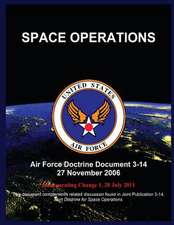Atlas Icbm Missile Weapon System Technical Manual: How Chrysler's Detroit Tank Arsenal Built the Tanks That Helped Win WWII
Autor United States Air Forceen Limba Engleză Paperback – 19 dec 2011
| Toate formatele și edițiile | Preț | Express |
|---|---|---|
| Paperback (1) | 314.08 lei 3-5 săpt. | |
| Periscope Film LLC – 19 dec 2011 | 314.08 lei 3-5 săpt. | |
| Hardback (1) | 376.76 lei 3-5 săpt. | |
| Periscope Film LLC – 20 dec 2011 | 376.76 lei 3-5 săpt. |
Preț: 314.08 lei
Nou
Puncte Express: 471
Preț estimativ în valută:
60.11€ • 62.52$ • 49.62£
60.11€ • 62.52$ • 49.62£
Carte disponibilă
Livrare economică 24 martie-07 aprilie
Preluare comenzi: 021 569.72.76
Specificații
ISBN-13: 9781937684907
ISBN-10: 1937684903
Pagini: 592
Dimensiuni: 203 x 254 x 30 mm
Greutate: 1.16 kg
Editura: Periscope Film LLC
ISBN-10: 1937684903
Pagini: 592
Dimensiuni: 203 x 254 x 30 mm
Greutate: 1.16 kg
Editura: Periscope Film LLC
Descriere
Created by the Air Force for the men who stood "on alert" with the Atlas, this technical manual contains descriptions of the HGM-16F missile, launch complex, handling and transport, checkout and launch operations, emergency procedures, and more. Originally restricted, it has been declassified and is reprinted here in book form.




![Spirit of '76 in Rhode Island [Published] with Cowell's Spirit of '76: An Analytical and Explanatory Index by James N. Arnold](https://i4.books-express.ro/bt/9780806319599/spirit-of-76-in-rhode-island-published-with-cowell-s-spirit-of-76.jpg)













